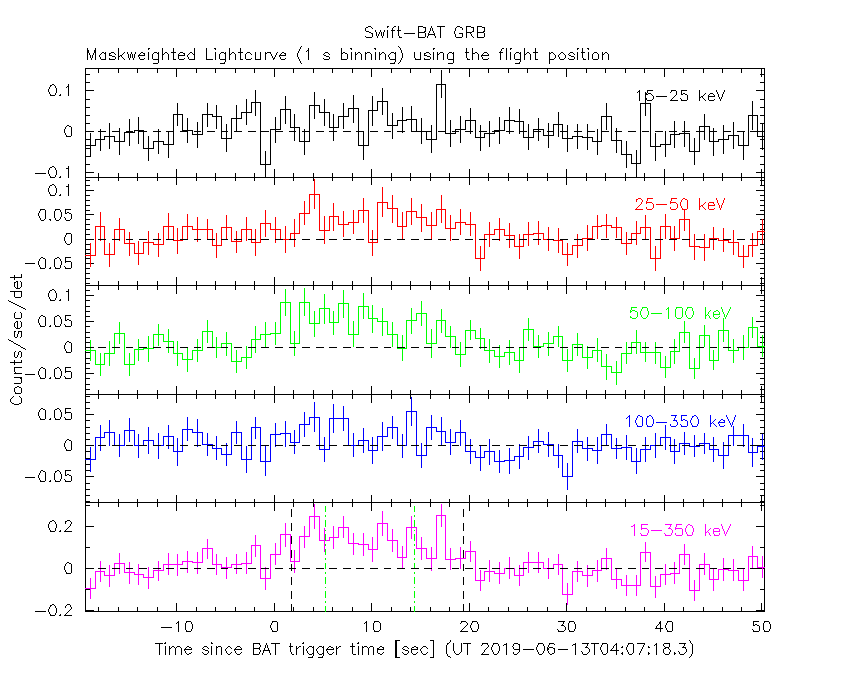
E. Ambrosi (INAF-IASFPA), D.N. Burrows (PSU) and F.E. Marshall (NASA/GSFC) for the Swift team
At 04:07:18 UT, the Swift Burst Alert Telescope (BAT) triggered and located GRB 190613A (trigger=908288) (Ambrosi et al. GCN Circ. 24798). Swift slewed immediately to the burst. At the time of the trigger, the initial BAT position was 73° from the Sun (6.8 hours East) and 76° from the 81%-illuminated Moon. Table 1 contains the best reported positions from Swift, and the latest XRT position can be viewed at http://www.swift.ac.uk/xrt_positions.
Ambrosi et al. (GCN Circ. 24798) reported the discovery with UVOT of an optical afterglow. Table 2 is a summary of GCN Circulars about this GRB from observatories other than Swift.
Standard analysis products for this burst are available at https://gcn.gsfc.nasa.gov/swift_gnd_ana.html.
As reported by Stamatikos et al. (GCN Circ. 24819),
the BAT ground-calculated position is RA, Dec = 182.552, 67.244 deg which is RA(J2000) = 1
The mask-weighted light curve (Figure 1) shows a weak pulse that starts at ~
The time-averaged spectrum from T+0.6 to T+20.3 s is best fit by a simple power-law model.
The power law index of the time-averaged spectrum is 1.22 ± 0.26.
The fluence in the 15-150 keV band is 1.7 ± 0.3 x 1
The results of the batgrbproduct analysis are available at https://gcn.gsfc.nasa.gov/notices_s/908288/BA/.
Analysis of the initial XRT data was reported by Burrows et al. (GCN Circ. 24810). We have analysed 16 ks of XRT data for GRB 190613A, from 128 s to 229.8 ks after the BAT trigger. The data comprise 127 s in Windowed Timing (WT) mode (the first 6 s were taken while Swift was slewing) with the remainder in Photon Counting (PC) mode. The enhanced XRT position for this burst was given by Osborne et al. (GCN Circ. 24809).
The light curve (Figure 2) can be modelled with a series of power-law decays. The initial decay index is α=2.00 ± 0.27. At T+243 s the decay steepens to an α of 8.0 (+0.0, -1.0) before breaking again at T+322 s to a final decay with index α=1.26 (+0.13, -0.11).
A spectrum formed from the WT mode data can be fitted with an absorbed power-law with a photon spectral index of 2.01 ± 0.12. The best-fitting absorption column is 5.2 (+2.8, -2.6) x 1
A summary of the PC-mode spectrum is thus:
Total column: 2.5 (+4.7, -1.0) x 1
Galactic foreground: 1.5 x 1
Excess significance: <1.6 σ
Photon index: 1.78 (+0.21, -0.15)
The results of the XRT team automatic analysis are available at http://www.swift.ac.uk/xrt_products/00908288.
The Swift/UVOT began settled observations of the field of GRB 190613A 145 s after the BAT trigger
(Marshall and Ambrosi GCN Circ. 24815).
A source consistent with the enhanced XRT position (Osborne et al. GCN Circ. 24809) is detected in the initial UVOT exposures.
Table 3 gives preliminary
magnitudes using the UVOT photometric system
(Breeveld et al. 2011, AIP Conf. Proc., 1358, 373).
No correction has been made for the expected extinction in the Milky Way
corresponding to a reddening of

Figure 1. The BAT
mask-weighted light curve in the four individual and total
energy bands. The units are counts

Figure 2. The XRT light curve.
Any data from a crosshatched region are not included in the fit.
| RA (J2000) | Dec (J2000) | Error | Note | Reference |
|---|---|---|---|---|
| 1 |
+67°14'07.0" | 0.43" | UVOT-refined | Marshall and Ambrosi GCN Circ. 24815 |
| 1 |
+67°14'07.2" | 1.5" | XRT-final | UKSSDC |
| 1 |
+67°14'07.3" | 1.5" | XRT-enhanced | Osborne et al. GCN Circ. 24809 |
| 1 |
+67°14'39.7" | 2.2' | BAT-refined | Stamatikos et al. GCN Circ. 24819 |
| Band | Authors | GCN Circ. | Subject | Observatory | Notes |
|---|---|---|---|---|---|
| Optical | Zheng and Filippenko | 24801 | KAIT Optical Afterglow Confirmation | KAIT | detection |
| Optical | Lipunov et al. | 24802 | Swift GRB190613.17 Global MASTER-Net observations report |
MASTER | |
| Optical | Lipunov et al. | 24803 | MASTER OT detection | MASTER | detection |
| Optical | Jelinek et al. | 24822 | FRAM-ORM afterglow detection | FRAM | detection |
| Optical | Belkin et al. | 24838 | Kitab and AbAO optical upper limit | Abastumani Astro. Obs. | upper limits |
| Optical | Cunningham and Neill | 24850 | SEDM Observations | Spectral Energy Distribution Machine at Palomar | |
| Gamma-ray | Fermi | 24799 | Fermi GBM Final Real-time Localization | Fermi GBM | |
| Gamma-ray | Burgess et al. | 24800 | BALROG localization (Fermi Trigger 582091643 / GRB 190613172) |
BALROG | |
| Gamma-ray | Poolakkil and Meegan | 24816 | Fermi GBM detection | Fermi GBM | Fluence=3.092±0.129x1 (4 |
| Filter | Exp(s) | Mag | ||
|---|---|---|---|---|
| white | 145 | 295 | 147 | 17.88 ± 0.04 |
| v | 634 | 1061 | 58 | 18.63 ± 0.29 |
| b | 560 | 753 | 39 | 18.93 ± 0.21 |
| u | 303 | 553 | 246 | 18.88 ± 0.11 |
| w1 | 685 | 11118 | 1121 | >20.1 |
| m2 | 5323 | 6859 | 296 | >20.8 |
| w2 | 4913 | 6548 | 393 | >21.5 |
Table 3. UVOT observations reported by Marshall and Ambrosi (GCN Circ. 24815). The start and stop times of the exposures are given in seconds since the BAT trigger. The preliminary detections and 3-σ upper limits are given. No correction has been made for extinction in the Milky Way.
June 20, 2019